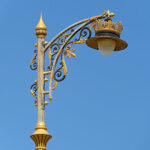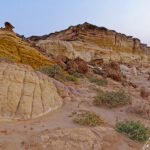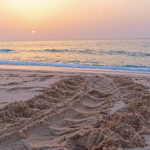The coast of the Sultanate of Oman, at the eastern end of the Arabian Peninsula, offers many attractions. For millennia fishermen have navigated this long, pristine coastline of over 1,865 miles (3,165 kilometers.) The coast is lined with sand-colored forts built during the Portuguese colonization of the 16th century. Along the Arabian Sea vast deserted beaches stretch as far as the eye can see. In Sour (or Sur) in northeastern Oman, the old shipyard sites, also called « dhow », will take you back in time… Dhow is a generic name for traditional sailing vessels used in the Red Sea and the Indian Ocean. Lastly, for fans of Sammy or Crush but also just for nature-lovers, Ras al-Jinz Turtle Reserve is a unique place, a significant nesting site for the endangered green sea turtle (Chelonia mydas). More than 30,000 females return every year to lay their eggs on the same beach where they were born decades ago: Home Sweet Home !
Muscat’s coastline: Royal Palace and Portuguese forts
Whether you choose to travel by road along the coast or prefer a traditional wooden boat (dhow), Oman is dotted with imposing lookout towers and Portuguese forts dating back to the 16th century. Sometimes the past meets the present, for example where the giant Al-Riyam incense burner in Riyam Park and an ancient lookout tower. The coast of Muscat would not have been an easy conquest, especially after the construction of the twin forts Al-Mirani and Al-Jalali on the western and eastern sides respectively of the entrance to the port of Muscat. Erected by the Portuguese these two forts are perched on the rocks protecting the harbor of Old Muscat. They are proud witnesses to the strategic and maritime past of the city, which was a trading post on the ancient route to India.

Fort Al-Mirani dates from 1550, and Fort Al-Jalali, also known as Fort Ash Sharquiya dates from 1587. The origin of Al-Jalali is unknown. The Portuguese name for Al-Jalali is São João. One theory behind the present name is that Al-Jalali comes from the Arabic Al Jalal, which means « great beauty ». Still, another theory is that the fort owes its name to the Persian ruler Jalal Shah. Until the 1970s remoteness made Fort Al-Jalali a perfect prison. It was restored in 1983 and converted into a private museum of the history of the Sultanate of Oman. Unfortunately, the museum is only open to VIP visitors (i.e., royal families or heads of state).

Fort Al-Mirani has a curious history. A tale says that its Portuguese commander was in love with and wanted to marry a merchant’s daughter. Like the scribe of Asterix, this Portuguese commander must have hummed « I thank life, I sing life, I dance life, I’m love…! ».However, his future father-in-law forbad the union on religious grounds. When the commander threatened to ruin the merchant, he pretended to accept and prepared for the marriage for a whole year. He convinced the commander that the fort’s supplies had to be completely reorganized and all the grain and ammunition reserves removed. Once the fort was completely empty of its supplies and gunpowder, the merchant alerted Sultan Ibn Said al Yarubi, who quickly conquered it in 1649. After the thunderbolt came the warning shot. The Portuguese left Muscat shortly afterward. When it is said that love makes us blind, it is not just empty words !

The two forts surround the Royal Palace (Qasr al-‘Alam or Palace of the Flag in Arabic). Built-in 1972, this palace with its blue and gold shades and modern Islamic architecture seems straight out of a tale from the ‘Thousand and One Nights’. Qasr al-‘Alam is one of the Sultan’s six residences. He rarely stays at Qasr al-‘Alam, preferring his other residences in Al Seeb and Manah. The Qasr al-‘Alam Palace is mainly used for official functions and ceremonies and to host distinguished visitors, including the Queen of England and the Queen of the Netherlands. White government buildings with crenelated rooftops and wooden balconies in traditional Omani style, including the Ministry of Finance, surround the palace.
« Oh my boat / You are the most beautiful of boats / And you guide me on the waves / Towards the most beautiful / You are the most beautiful of boats / Braving all storms / Whistling like a lark / I fly (it flies) / Towards fabulous shores »
(Eric Morana – Oh ! mon bateau)
In the late afternoon, as the sun goes down behind the mountains, two floating luxurious residences of the Sultan glisten in the harbor. The yacht « Al Said », 508 feet long (155 meters) and costing about 300 million dollars, can accommodate up to 65 guests and features a concert hall large enough for an orchestra of 50 musicians… A little extravagance for the music-loving sultan! To the right of the « Al Said » is the 538 foot long (164-meter) super-yacht « Fulk Al Salamah », which can accommodate up to 350 travelers in the greatest luxury.
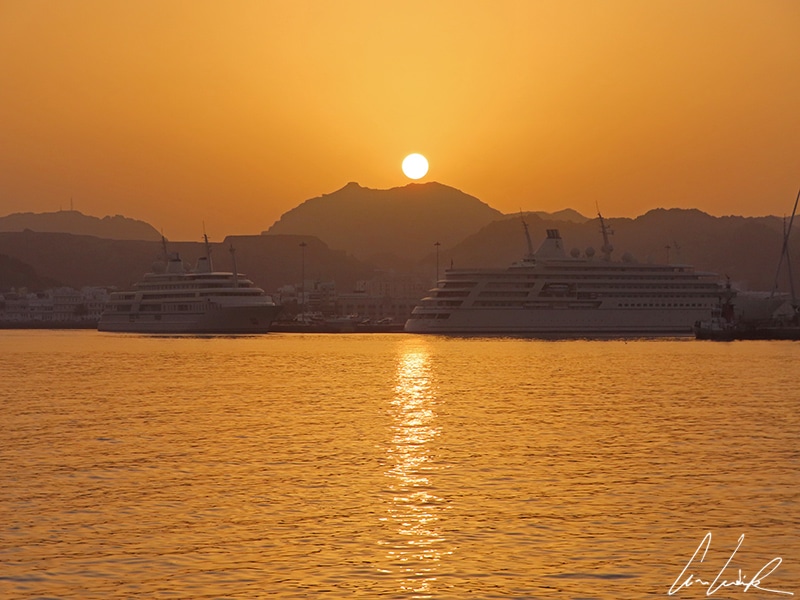
The city of Sour: in search with Sindbad the sailor
Thanks to 1,865 miles of coastline (3165 kilometers,) the history of the Sultanate of Oman is closely linked to the sea and to trade between East and West. Located on the coast, about 93 miles (200 kilometers) southeast of the Omani capital Muscat, the city of Sour(Arabic صور) will take you back in time. First, the road sign « Warning Camel crossing », reminds us how these animals, nicknamed « Ships of the desert » have played a vital role in Oman for thousands of years. In 1989, a Royal Camels Unit was even created to preserve this national heritage. Besides being an indispensable means of travel, food (meat or milk), and clothing, Camels also contribute to entertainment and competition. Camel racing is famous in the countries of the Arabian Peninsula. You may think that a Camel is slow ? On the contrary, it can run very fast attaining speeds of up to 44 mph. That’s faster than any horse !

We travel back in time when we stroll on the cornice of Sour (or Sur) with its lamp posts from another epoch. In the early morning when dhows return from fishing they pass the imposing eye of the 60-foot high lighthouse (18 meters) overlooking the bay. During the day, traditional dhows rest in the harbor. Fishing in the middle of the day is difficult: the sun hits the water hard, and the fish retreat to cooler waters on the bottom. That’s why you have to go early or at night. In Sour, residents practice small-scale coastal and artisanal fishing, often for just for their own family. Crews are commonly just two people. On a family boat with a Yamaha engine of barely 200 horsepower, father and son start in the early morning and head out on the Arabian Sea, scanning the horizon in search of groups of cormorants. After sighting the birds, the fishermen quickly deploy lines and nets. Fish thus caught are included in tallies of the tonnages of fish caught in the country.
« Casting on the water / Casting nets / Casting nets on the water / A boat / Being happy on it / Being on a boat / I dream of water / But of the Ocean / Ah! The Ocean / Fishing on it »
(Laurent Voulzy – Le rêve du pêcheur)
A more « organized » form of fishing consisting of independent fishermen or small fishing companies with fleets has also developed in Sour. Usually the owner is an Omani employing undocumented Bangladeshi and Indian workers. Bangladeshi and Indians come from a fishing culture and work to exhaustion for little money… Nowadays, no Omani wants to sail the sea like Sindbad the sailor; it’s too difficult ! Sardines and anchovies represent the biggest tonnages. Traditionally, sardines are not often eaten by people. They are dried and used as supplementary food for livestock: cattle and camelids. Sour’s fish market is packed with a wide variety of fish from the Gulf: bright-colored yellowfin tuna, small sharks, bonito, groupers, emperors, frigate tuna, common jacks and red mullets.

Omani authorities have a strong interest in the fishing industry, which was for years, before the discovery of oil in the 1960s, the main economic activity of the Sultanate of Oman. With a self-sufficiency rate of 176%, the Sultanate is a net fish exporter. But the modernization of the fishing and aquaculture sector will be long and difficult, given that 99% of fish captured are still caught by traditional methods. Turning to more industrial exploitation of the seabed and having Omanis once again man ships is a major challenge for the new sultan.

Sour and the dhow’s yards
For centuries shipbuilding was the Sultanate of Oman‘s primary industry, but even after the death of this industry in the second half of the 19th century, the city of Sour has preserved memory of the techniques and know-how of dhow construction. Visiting a dhows shipyard (« dhow » or daou in Arabic: داو) is a bit like going back in time to a distant past when shipbuilding and ship repair were essential activities for maritime trade. These vessels can cross the ocean as far as China, India, Zanzibar, and many other destinations, or just sail along the coast. The different models employ the same design, a shape able to resist the force of the waves, and use the same manufacturing techniques. The tools used today are almost identical to those of the 19th century. Although more resistant and cheaper fiberglass hulls have entered the market, a few rare teak wood dhows are still manufactured.

Dhows are used for fishing (the Belem, the Sambuk: once for pearl fishing, the Shu’ai, or the more modest Jaliboot), tourism, and the transport of goods (the Bum, the Baghala, the Ganja or the Zarouk: pirate and smuggler favourite). Typically a dhow has a capacity of 50 to 200 tons. We can watch the construction of a dhow… A worker (often of Indian origin) is perched on a frail and precarious scaffolding. With his adze, a tool that dates back to the Stone Age, in hand he follows the instructions of the old boat builder and carves and smoothes the wood. There is no plan, no map, and no instructions to know where to cut. It’s all in the builder’s brain. The master-builder thinks, and his workers apply the instructions and assemble the boat as the builder wishes… The workers still plane the wooden planks by hand with gestures from another age. The manufacture of the dhow starts with the keel. The experience of the boat builder is essential to achieve the right edge to ensure that the first plank is watertight. Then all the planks are placed on the side to make lines. It is these wooden planks that give the shape of the boat. The hull is assembled without any nails, only with hand-braided ropes. The work is slow, each task seems endless, but in a few months, the little craft will be ready to sail on the waves, ahoy, ahoy… Ahoy, ahoy sailor.

Turtle nesting on the beach of Ras al-Jinz : an exceptional moment
Witnessing the turtles laying their eggs on an Omani beach is awe-inspiring. The best spot is to see the turtles is Ras al-Jinz (Arabic:رَأْس ٱلْجِنْز) or Ras al Junayz (Arabic: رَأْس ٱلْجُنَيْز) on the easternmost point of the Arabian Peninsula. It is where daylight first comes to the Arab world. The beach itself is beautiful with stunning, colorful cliffs. There are orange-colored rocks, carved and sculpted. Their most beautiful colors are revealed at sunrise when the first rays of the sun hit their strange shapes. There is no one on the beach except for a few birds circling above the cliffs. This vast sandy expanse feels like a No Man’s land, you can walk for hours without meeting a living soul, only a few colorful crabs (Grapsus albolineatus).
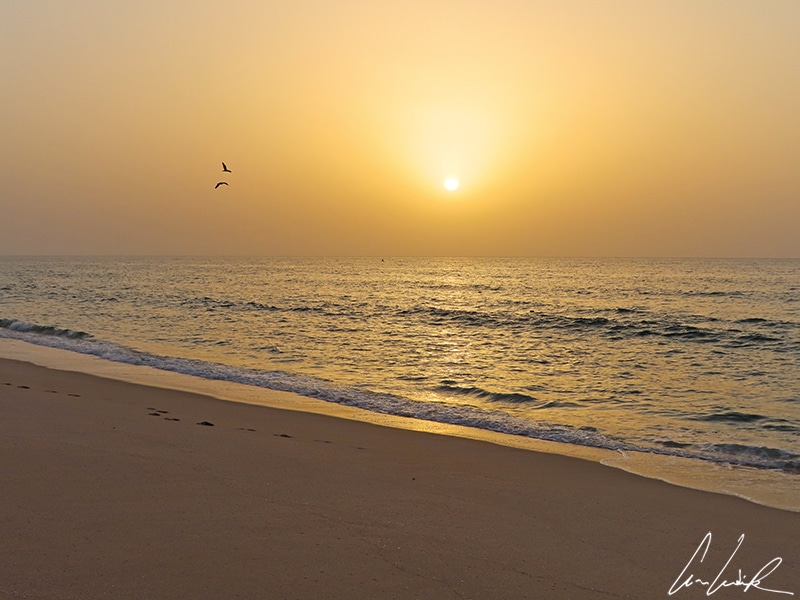
A royal decree of 1996 established the Ras al-Jinz Turtle Reserve specifically to protect sea turtles. Sea turtles have inhabited our oceans for more than 150 million years. They have rubbed shoulders with dinosaurs and have survived numerous climate crises. After having come so far, however, will turtles manage to survive against their main predator, Man? Persistent hunting, increasing coastal development, accidental capture in fishing nets, marine pollution, and the degradation and destruction of nesting beaches mean that, currently, six of the seven living species of marine turtles are considered threatened or severely endangered.

Ras al-Jinz Reserve hosts an estimated 30,000 Green nesting turtles every year. The reserve plays a major role in the preservation of the species. Nesting can take place up to five times per season, at intervals of up to 14 days. On average, the sea turtle lays up to 100 eggs in a clutch, and these incubate in the warm sand for about 60 days. Baby turtles hatch from their nest in masse, giving the impression of boiling sand, and rush to the sea together to increase their chance of escaping predatory sea birds. Although reproducing massively, the mortality of green turtles is very high, especially in the early years. Of one to two thousand newly hatched sea turtles only one will survive to adulthood. Natural selection is merciless !
« He lets the Tortoise plod along / Grave as a senator / To race / With such a thing is but a disgrace. / She, in the meanwhile, strives and strains, / And takes most meticulous pains; / Slow, yet unceasing »
(Jean De la Fontaine – The Hare and the Turquoise).
Under a starry night, pregnant female turtles return year after year to the beach where they hatched years before (or in the vicinity). They swim and go through crushing surf, drag themselves out of the water, and crawl up the beach. The Green turtles are reputed fast in the open ocean, able to attain a speed of up to 22mph. However, they are not so good at crawling on sand and progress with infinite slowness. Once they reach a secure nesting spot above the high tide line, usually near a dune, the female turtle digs a large hole. She uses her back flippers to scoop sand and dump it to the side. The turtle’s nest is up to one and a half times its size. With its heart-shaped shell, an adult turtle can measure up to 5 feet. A mature female, aged 30 years or older, can be more than 4 feet long and weigh more than 440 pounds.

Using its posterior flippers, the green turtle digs a hole about 27 inches deep and lays about 100 eggs each the size of a golf ball. The eggs don’t have hard shells, instead, each is coated with a flexible leathery mucus. The eggs fall out in rhythmic contractions of 1, 2, 3, or 4 to the bottom of the hole. The flexible mucus allows the egg to survive the fall. In total, they represent 5 to 6 kilograms. The laying process takes about 20 minutes. The female turtle then fills her hole and camouflages the nest by covering a large area with sand so that it is impossible to know where she laid her eggs. The remaining holes on the beach are only tricks for predators. The whole process can take from one to two hours. Exhausted, the turtle drags herself slowly back to the ocean, leaving a characteristic pattern in the sand. Then she swims away again, carried along by rolling waves.
« Time sometimes flies like a bird, sometimes crawls like a tortoise; but people may be unusually happy when they do not even notice whether time has passed quickly or slowly ».
(Ivan SergeevichTurgenev, Fathers and sons)
About eight weeks after the egg-laying, baby turtles make their way in unison to the surface of the sand. The outside temperature determines the time of birth. If it’s too hot, the small tortoises will remain buried in the sand; but as soon as it gets cooler, the small tortoises go out in masse and run to the ocean. The temperature of the sand determines the gender of the turtle. Warm sand produces more females and cooler sand more males. The thermosensitive period begins soon after the eggs are laid. Eggs incubated at lower temperatures (71-80°F.) produce only males. In contrast, eggs incubated at higher temperatures (86°F and above.) produce females. Temperatures between 80°F and 86°F will give a nest of both genders. This phenomenon is called Temperature sex determination (TSD.)

Ten to fifty years after hatching, depending on the species, the adult female turtle reaches sexual maturity. Watching female turtles coming ashore at night, especially under a full moon, to lay their eggs is a unique and unforgettable experience. On land, turtles are very vulnerable, and if they are frightened or distressed, a female turtle may return to the sea before her eggs can be successfully laid. This can affect nesting success and, ultimately, the long-term survival of the species.
Find more on the Sultanate of Oman
- Muscat, capital of the Sultanate of Oman: A city walk in the anti-Dubai!
- The Natural Wonders of Oman: Green Wādī and Moving Sand
- Escapes in the Hajar Mountain Range
- The Sultanate of Oman in the time of Castles












